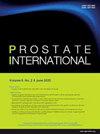Incidence and risk factors for dermatologic adverse events following apalutamide use: a real-world data analysis in the Korean population
IF 2.6
2区 医学
Q2 UROLOGY & NEPHROLOGY
引用次数: 0
Abstract
Purpose
This study aimed to assess the incidence, severity, and onset of dermatologic adverse events (dAEs) in Korean patients treated with apalutamide for metastatic hormone-sensitive prostate cancer (mHSPC) and to identify clinical and laboratory predisposing factors.
Materials and methods
We retrospectively analyzed data of patients treated with apalutamide for mHSPC at a tertiary referral center in Korea between April 2023 and March 2024. Patients with a radical prostatectomy history or insufficient data were excluded. The onset, severity, and management of dAEs were evaluated and compared between patients with and without dAEs. Clinical and laboratory data from 1 month prior to apalutamide administration were collected. Logistic regression was performed to identify predictors of dAEs, and the predictive value of serum albumin levels was analyzed using the receiver operating characteristic (ROC) curve.
Results
Twenty-six (40.0%) of the 65 patients developed dAEs, including nine (13.8%) with Grade ≥3 events. The median onset of dAEs was 66.5 (45–78) days. Patients with dAEs had significantly lower initial prostate-specific antigen levels (70.4 vs. 301.6 ng/mL), higher Eastern Cooperative Oncology Group Performance Status (ECOG-PS; 30.8% vs. 5.1%), and lower serum albumin levels (3.8 vs. 4.1 g/dL). Logistic regression identified elevated Eastern Cooperative Oncology Group-Performance Status (ECOG-PS) and hypoalbuminemia as significant predictors of dAEs. ROC analysis for serum albumin levels produced an area under the curve of 0.739, with a cutoff value of 3.85 g/dL, yielding a sensitivity and specificity of 65.4% and 74.4%, respectively.
Conclusion
dAEs are prevalent in Korean patients treated with apalutamide for mHSPC, with ECOG-PS and serum albumin levels identified as significant risk factors.
阿帕鲁胺使用后皮肤不良事件的发生率和危险因素:韩国人群的真实数据分析
目的:本研究旨在评估韩国接受阿帕鲁胺治疗转移性激素敏感性前列腺癌(mHSPC)患者皮肤不良事件(dAEs)的发生率、严重程度和发作情况,并确定临床和实验室易感因素。材料和方法我们回顾性分析了2023年4月至2024年3月在韩国一家三级转诊中心接受阿帕鲁胺治疗mHSPC的患者的数据。排除有根治性前列腺切除术史或资料不充分的患者。评估和比较dAEs患者和非dAEs患者的发病、严重程度和管理。收集阿帕鲁胺给药前1个月的临床和实验室数据。采用Logistic回归确定dAEs的预测因素,并采用受试者工作特征(ROC)曲线分析血清白蛋白水平的预测值。结果65例患者中有26例(40.0%)发生dAEs,其中9例(13.8%)发生≥3级事件。dae的中位发病时间为66.5(45-78)天。dAEs患者的初始前列腺特异性抗原水平明显降低(70.4 vs 301.6 ng/mL),东部肿瘤合作组性能状态(ECOG-PS;30.8%对5.1%),血清白蛋白水平较低(3.8对4.1 g/dL)。Logistic回归发现东部肿瘤合作组绩效状态(ECOG-PS)升高和低白蛋白血症是dAEs的重要预测因素。对血清白蛋白水平进行ROC分析,曲线下面积为0.739,截断值为3.85 g/dL,敏感性和特异性分别为65.4%和74.4%。结论在韩国接受阿帕鲁胺治疗mHSPC的患者中,daes普遍存在,ECOG-PS和血清白蛋白水平被认为是重要的危险因素。
本文章由计算机程序翻译,如有差异,请以英文原文为准。
求助全文
约1分钟内获得全文
求助全文
来源期刊

Prostate International
Medicine-Urology
CiteScore
4.40
自引率
26.70%
发文量
40
审稿时长
35 days
期刊介绍:
Prostate International (Prostate Int, PI), the official English-language journal of Asian Pacific Prostate Society (APPS), is an international peer-reviewed academic journal dedicated to basic and clinical studies on prostate cancer, benign prostatic hyperplasia, prostatitis, and ...
 求助内容:
求助内容: 应助结果提醒方式:
应助结果提醒方式:


